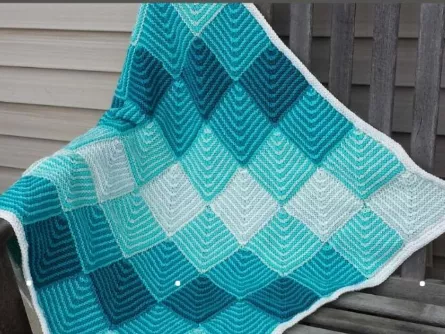
Crochet is an art form and expression that has delighted people around the world for generations.
Among the various techniques and stitches that make up the universe of crochet, the Tunisian stitch stands out as a versatile and impressive option.
In this article, we’re going to explore everything you need to know about Tunisian stitch crochet, from the basics to a free pattern for you to try.

Image From Pinterest – Free Pattern
The Tunisian stitch, also known as Afghan crochet or knitting crochet, is a technique that combines elements of crochet and knitting, resulting in a unique and beautiful texture.
Unlike traditional crochet, which uses only one needle, the Tunisian stitch is worked with a long needle, similar to a knitting needle, but with a hook at the end.
Tunisian stitch creates a denser, tighter fabric compared to traditional crochet, making it perfect for projects like throws, scarves, headwear, and even garments.
The texture offered by this stitch is unique, often reminiscent of a knit stitch, but with an even more elaborate appearance.
Before we dive into the free pattern, it’s important to have an understanding of the basics of Tunisian stitch crochet. Follow these steps to get started:
Step 1: Assembly of points
Use a Tunisian needle suitable for the yarn size you have chosen.
Make a chain with the desired number of stitches.
Insert the hook into the second stitch from the hook and grab the loop, keeping it on the hook.
Step 2: Pathway
Insert the hook into the next stitch on the chain and grab the loop.
Keep repeating this process until the end of the row.
At the end of the row you should have all the loops on the Tunisian needle.
Step 3: Career back
For the back row, insert the hook into the first loop (closest to the needle) and pick up the loop.
Now keep repeating this process, picking up one loop at a time, until you reach the end of the row.
Step 4: Repetition
Repeat back and forth rows until you reach the desired length for your project.
Remember that the Tunisian stitch technique can be used for many different stitches, such as single stitch, double stitch and twist stitch, each creating a different texture.
Subtitle 3: Free Pattern Using Tunisian Stitch
Now that you understand the basics of Tunisian stitch crochet, how about putting your knowledge to use with a free pattern for a beautiful headband with a unique texture?
Hair Band with Tunisian Stitch
Materials:
Medium cotton yarn in two colors of your choice.
Tunisian needle suitable for yarn.
Tapestry needle.
Hair elastic.
Instructions:
Step 1: Assembly
With color A, make a chain of 10 stitches.
Switch to color B.
Step 2: Round-trip careers
Work 4 rows back and forth in simple Tunisian stitch, alternating between colors A and B on each row.
Step 3: Cross Stitch
With color A, work 2 rows in twisted Tunisian stitch.
Step 4: Round trips
Continue alternating between colors A and B, working 4 rows in simple Tunisian stitch.

Fold the strip in half, lining up the edges.
Using a tapestry needle, sew the edges together to form the band.
Attach a piece of hair elastic to the ends of the headband, forming a loop.
Tunisian stitch crochet offers a multitude of creative possibilities. In addition to the headband pattern above, you can experiment with different stitches, colors, and yarn types to create unique and stunning pieces. Some ideas include:
Throws and Blankets: The density of Tunisian stitch makes it perfect for creating warm, cozy throws. Experiment with color combinations for a unique look.
Scarves and Shawls: The striking texture of Tunisian stitch is ideal for adding depth to accessories such as scarves and shawls.
Garment Pieces: Explore creating cardigans, vests and even dresses using Tunisian stitch. Its unique look is sure to make your piece stand out.
Handbags and Accessories: Handbags, purses and other accessories are charming when worked with Tunisian stitch. You can incorporate different stitches to create interesting patterns.
Tunisian stitch crochet is a fascinating technique that allows crocheters to create pieces of unique and impressive texture. With its similarity to knitting, this stitch offers an intriguing alternative to traditional crochet.
We hope this article has given you a solid understanding of the basics of Tunisian stitch crochet and inspired you to try out the technique via the free pattern provided.
[activecampaign form=1 css=1]
Remember that the key to successful crochet is practice, so grab your Tunisian needle and favorite yarn and start creating wonderful, one-of-a-kind pieces.